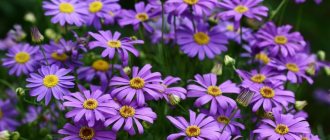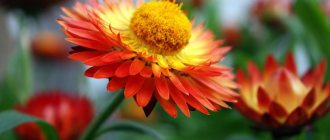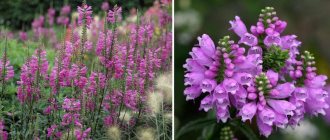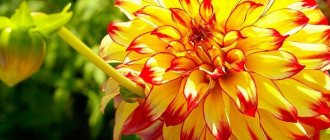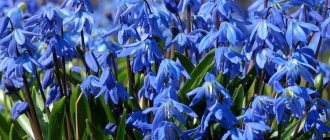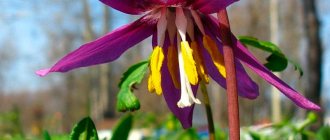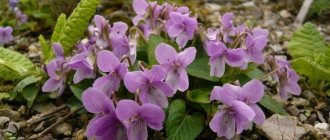Author: Elena N. https://floristics.info/ru/index.php?option=com_contact&view=contact&id=19 Category: Garden plants Published: March 07, 2018Last edits: November 04, 2020
- Growing conditions
- Chionodoxa forbesii
Chionodoxa (lat. Chionodoxa) are low-growing perennials of the Scylla genus of the Liliaceae family, of which 6 species are known. Chionodoxes grow in Asia Minor and on the island of Crete. The name of the genus is formed from two Greek words: “snow” and “pride, glory”, and among the people Chionodoxa is called “snow beauty” or “snowman”: this delicate plant with wonderful flowers appears along with woodlands and snowdrops when it is still lying on the ground snow.
Planting and caring for Chionodoxa
- Flowering: for 2-3 weeks in April, together with snowdrops and scillas.
- Planting: September-October.
- Lighting: bright sun or partial shade.
- Soil: loose. Moderately moist, well fertilized, neutral or alkaline reaction.
- Watering: only during drought, that is, if the winter was without snow and spring without rain. Watering is carried out early in the morning.
- Feeding: Nitroammophoska. Granular fertilizers are scattered over the area and incorporated into the soil through shallow loosening.
- Reproduction: by dividing the bulbous nest.
- Pests: meadow root mites and rodents.
- Diseases: gray mold, sclerotinia, fusarium, septoria and Achelenchoides.
Read more about growing Chionodoxa below.
Description of Chionodoxa and its photo
There are several distinctive features of the flower to distinguish it from similar species - these are the perianths, which are connected in the shape of a tube, and the smooth stamens, which are smooth like the stems and look like a cup in the center of the flower itself. But despite this, some botanists still include them in the genus Scylla. A description of Chionodoxa is offered by many gardeners, but each of them sees the plant in his own way. Therefore, it is better to look at a photo of Chionodoxa and evaluate its advantages:
The inflorescences are formed from star-shaped blue flowers with white centers and appear 4-11 on a single stem. Usually in summer the foliage on the flower disappears.
Botanical description
Chionodoxa flowers are bulbous plants with two basal leaves appearing simultaneously with the peduncles - dark green, broadly lanceolate, grooved, 8-12 cm long. The peduncles bear loose racemose inflorescences of bell-shaped six-petaled flowers of white, blue, indigo or pink. The fruit of the plant is a juicy capsule in which black Chionodoxa seeds ripen. The ovoid bulbs, up to 3 cm long and up to 1.7 cm in diameter, are covered with light scales and are designed for two annual cycles.
Features of Chionodox
Chionodoxes are bulbous plants. At the same time as the peduncles, a pair of basal leaf plates of a dark green color grow; they are grooved and broadly lanceolate, and reach a length of 8 to 12 centimeters. Loose racemes located on peduncles consist of six-petaled, bell-shaped flowers that are blue, pink, white or blue. The fruit is a juicy capsule, and inside it there are black seeds. The ovoid bulbs reach about 30 mm in length and approximately 17 mm in diameter. Their surface is covered with light-colored scales. These bulbs are designed for 2 year cycles.
Plants for alpine hills. Chionodox planting and care
Planting Chionodoxa in open ground
When to plant
It is best to plant Chionodoxa bulbs in early autumn, when root ridges have formed on their bottoms. The plant grows well both in sunny areas and in partial shade. If you want early flowering, plant the bulbs where the snow melts first. When grown in partial shade, flowering of Chionodoxa may begin a little later than in the sun, but will last longer. You can plant these plants even under trees and bushes, because when Chionodoxa blooms, there are still no leaves on the bushes and trees that absorb the light that primroses need for growth and flowering.
Chionodoxa in open ground is best adjacent to plants such as primroses, hellebores, hyacinths, crocuses, pushkinias, white flowers, adonis and dwarf irises.
- Gladioli: growing in containers
How to plant
The soil on the site for Chionodoxa should be neutral or slightly alkaline, loose, moderately moist and well fertilized. The plant will settle in well and develop well if you add a little forest soil with rotted leaves and fragments of tree bark into the soil.
Planting Chionodoxa is carried out like planting any bulbous plant. How close and how deep to place Chionodoxa bulbs depends on their size. Large specimens are buried 6-8 cm, placing them in a row at a distance of 8-10 cm from each other. Smaller bulbs are buried 4-6 cm, keeping an interval of 6-8 cm between them.
Use in garden design
The Chionodox plant is used to decorate garden plots and parks. It can be seen in front of bushes or on alpine hills; the flower is often combined with other bulbous plants. Chionodoxa variety Blue Gigant looks good together with snow-white Pushkinia. Chionodoxa Alba combines beautifully with irises. Light hybrids of Chionodoxa Forbes are in harmony with Sparaxis and Ixia.
Chionodoxa serves as a decoration for landscape compositions
These unusual and attractive flowers become a decoration for any garden in spring. Chionodoxes are unpretentious and easily adapt to any conditions. Due to its resistance to frost, the crop is suitable for cultivation in the central and northern regions. If the rules of agricultural technology are followed, Chionodoxa will delight gardeners for a long time with its lush color.
Caring for Chionodoxa in the garden
Growing conditions
Planting and caring for Chionodoxa will not be difficult for you, since this flower is one of the most unpretentious early flowering plants. You will only need to water the flower garden if there was no snow in the winter and no rain in the spring. After moistening, you need to carefully loosen the soil around the plants, while removing weeds. To do this less often, mulch the surface of the area with humus or dry peat. Caring for chionodoxes includes fertilizing and replanting the plant, as well as, if necessary, treating the flower garden against pests or diseases. If you do not want Chionodox to reproduce by self-sowing, pick off their testes before they are ripe.
Watering and fertilizing
Systematic abundant watering is very important for Chionodoxa in dry weather. The soil is moistened early in the morning so that drops do not fall on the flowers. The water should not be cold and settled.
Mineral complexes are used as fertilizer, for example, Nitroammofoska, when applied in early spring, Chionodoxa responds with lush and long flowering. Granular fertilizers are scattered over the area, after which the surface is loosened shallowly so that it is quickly absorbed by the root system of the plants.
Transplantation and propagation
The easiest way for Chionodoxa to reproduce is vegetatively - by separating children from the mother's bulb, which grow from 2 to 4 in one season. In one place, Chionodoxa can grow for up to ten years, but it is better to dig up nests once every 5-6 years, separate them and seat. The bulbs need to be removed from the soil in the second half of July, when the above-ground part of the plant turns yellow and dries out. And the bulbs are planted in the ground, as we have already written, at the end of August or beginning of September, so before planting the nests are stored in a dry, dark place at a temperature of 15-17 ºC. Do not separate the babies from the mother bulb immediately after removal from the soil, because during storage the smallest of them may die. It is better to divide the nest before autumn planting, which is carried out according to the scheme we have already described.
- How to properly plant hydrangea in open ground
It is not advisable to grow Chionodoxa by seed, since they reproduce well by self-sowing: the seeds have a fleshy structure that is very popular with ants, who take the seeds far beyond the site. Chionodox from seeds bloom in 2-3 years.
Chionodoxa in winter
After flowering is completed, the chionodox shoots are cut off, but the leaves, as already written, are removed only after they wither - in the second or third decade of July. Chionodoxa tolerates winter frosts without any problems, but if you planted it in an open area, it is better to cover it with a heap of dry leaves or cover it with spruce paws for the winter. Although in the southern regions this precaution is unnecessary.
Propagation and collection of seeds
The crop is propagated using the vegetative method. The mother bulb will need to be divided into smaller bulbs. In one season, the plant usually grows 2-4 new bulbs. Many gardeners say that the plant can grow and bloom beautifully for 9-10 years without any replanting, but experienced botanists advise digging up a bush at the age of 5-6 years and dividing it.
Adult bush bulbs should be removed at the end of July. At this time, all the inflorescences will close, the foliage will begin to wither and go down. This signals that the plant is slowly entering a dormant state.
Bulbs should be planted at the beginning of the autumn period. Seedlings should be kept in a cool and dry place. Moreover, it is important to separate young bulbs from the mother immediately before planting in open soil.
Chionodoxa seed division produces virtually no results. Even if the variety has seeds that ripen at the end of the season, they will fall out of the cracked “boxes” (if they are not trimmed in time). Juicy grains will attract ant colonies, which will spread the seeds throughout the summer cottage. Usually such plants do not take root normally and do not produce inflorescences.
Pests and diseases
Like any other bulbous plant, Chionodoxa is susceptible to fungal diseases such as gray rot, sclerotinia, fusarium, septoria and Achelenchoides. The problem is that these diseases affect the bulb located underground, and we observe, as they say, the last act of the performance - yellowing and drying of the leaves, but we no longer have time to save the plant. Therefore, it is advisable to treat the planting material before planting in a Fundazol solution and observe moderation when watering, avoiding stagnation of water and, as a result, rotting of the bulbs.
The most dangerous pests for Chionodoxa are the larvae of root meadow mites and rodents that damage plant bulbs. Treating the plant with acaricidal preparations (Aktara, Akarin, Actellik, Agravertin and the like) is effective against ticks, and mice and moles are gotten rid of by spreading poisoned baits around the area.
When and how does it bloom
Together with other snowdrops, the corollas of Chionodox appear in flower beds along with the first streams of melted snow.
Types of flowers
Usually the corolla consists of 5 petals and resembles a bell. In some varieties, the petals may have veins that are brighter than the main color. In the center are stamens, usually sprinkled with yellow pollen.
Flower shapes
In different varieties and species, the flowers have the same structure of 6 petals, but can be collected in larger or larger brushes at the ends of long (10-20 cm) peduncles of 2-4 or 10-15 buds.
Flowering period
Usually, 2 weeks pass from dissolution to complete wilting of the inflorescences. However, the newest varieties can show more impressive results: 20 and even 30 days. Those plants that are in bright light bloom earlier, and those in the shade later.
Changes in care during the flowering period
During the blooming of buds, watering with the addition of a weak concentration of organic fertilizer will help spur plants to active growth.
Types and varieties
As already mentioned, scientists have described six species of Chionodoxa, but only three of them are grown in culture, as well as varieties and hybrids of different plant species.
Chionodoxa forbesii
Or Chionodoxa tmolusi is found naturally in southern Turkey. This species reaches a height of 25 cm. The plant forms a loose raceme on the peduncle, consisting of up to 15 white or pink flowers. This species does not produce seeds, but the bulbs grow annually as children. Chionodoxa Forbesia has been in culture since 1976. The following cultivated plant varieties are known:
- Alba - chionodoxa with snow-white flowers;
- Chionodoxa Blue Giant - a variety with perianths of intense blue color;
- Pink Giant is a garden form with lavender-pink flowers.
Chionodoxa luciliae
Or the giant chionodoxa (Chionodoxa gigantea) is named after Lucille Boissier. Chionodoxa grows in the mountains of Asia Minor, reaching a height of only 20 cm. The leaves of plants of this species are grooved and linear. Flowers, up to 3 cm in diameter, blue-blue with a white throat, are collected in inflorescences in quantities of up to 10 pieces. The species has been in cultivation since 1764. The following varieties of Chionodoxa Lucilia are popular:
- Master class - how to get 90% rooting of surfinia (petunia) cuttings?
- white - a plant up to 10 cm high with white flowers up to 2.5 cm in diameter, of which there are 3-4 in one brush;
- pink – the color of the flowers is pink with a slight purple tint.
Gardeners are interested in a variety of pink variety - Chionodoxa Rose Queen (aka Rosie Queen or Pink Queen), the flowers of which are distinguished by a very beautiful shade of pink.
There is another variety of Chionodoxa Lucilia - a giant white one with flowers up to 4 cm in diameter.
Chionodoxa sardensis
also native to Asia Minor. This is a plant with two linear leaves, strong peduncles up to 12 cm high, which bear up to 10 bright blue flowers up to 2 cm in diameter, collected in a loose raceme. The plant has been in cultivation since 1885. The species has garden forms with white and pink flowers.
Also known are Chionodoxa dwarf, or Cretan, Chionodoxa whitish and Mrs. Lock, which were used to obtain new varieties, but have not yet been introduced into cultivation. With the participation of different species of Chionodoxa, breeder V. Khondyrev created a series of wonderful hybrids: Watercolor, Artemis, Absolute, Atlantis, Andromeda, Aphrodite and Arctic. Hybrids between related plants Chionodoxa Forbes and Scylla bifolia, which are called Chionoscilla, are also popular. They do not exceed 10 cm in height, and their small blue star-shaped flowers are formed not into loose inflorescences, like those of Chionodoxa, but into dense inflorescences.
Chionodoxa: combination with other plants
Charming spring crumbs are often used to decorate flower beds and spring lawns in combination with other perennial crops. Chionodox will be in excellent company with amazing primroses, graceful liverworts, and delicate hellebores. This flower feels very harmonious with sunny daffodils, dwarf irises, perennial hyacinths and even crocuses.
Chionodoxa goes well with other primroses
What is a Chionodox flower?
The Chionodox flower is a bulbous plant. It is from the bulb that the first shoots appear in the spring, and then the leaf blades and peduncles.
The leaves are 8-12 cm long. They are colored rich green. But the inflorescences of this spring flower are of much greater interest. They have the shape of a small bell and are collected in flowing brushes (Figure 1).
Figure 1. Chionodoxa is one of the earliest primroses.
At first glance, it may seem that Chionodoxa blooms unremarkably, because its petals are not brightly colored, and are only pale blue, white or pink. But given the fact that the culture itself belongs to the Daylily family, and its main characteristic is the earlier onset of flowering, it is still worth growing such a flower on your own plot. Considering that the popular name of the culture is “snow beauty”, it is one of the first to bloom in the flowerbed. At the same time, the plant does not require special care at home and will become an excellent decoration for the garden in early spring.
